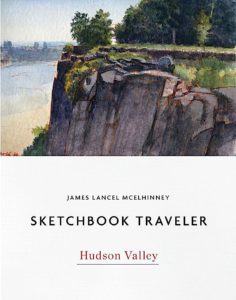Waiting for the crisis to pass, our thoughts go out to friends and loved-ones who also shelter in place. Old friends pass away, people we loved and admired. Immobilized for the time being, we can revisit destinations, near and far. join me in celebrating the joys of Quaranteam travel, the hope that these diversions might inspire us to value things we had taken for granted, to draw strength, wisdom and compassion from deeper engagements with nature.

Lake Minnewaska.
. (Image and text were featured in the exhibition James McElhinney. Discover the Hudson Anew, curated by Laura Vookles. Hudson River Museum. Yonkers, New York. September 13, 2019 to February 16, 2020. Published also as a limited-edition in Hudson Highlands. North River Suite Volume One. Needlewatcher Editions. New York. 2018)
Shawangunk Ridge is a former seabed. In the Lenape tongue the name means “smoky air,” inspired perhaps by the clouds that drift around its summit, like the mountains in western North Carolina and eastern Tennessee. Debates continue to rage about the correct pronunciation of the Munsee-Lenape word sha-wan-gunk. During the eighteenth century, colonists started saying shon-gum, which by persistent usage has continued to this day.
The debate continues, but having grown up surrounded by Lenape place-names, sha-wan-gunk sound more authentic, while shon-gum sounds more like the Hooked-on-Phonics version. In 2004, a cub-scout troop demanded the town of Shawangunk change the spelling of its name.
This reeks of Anglo-Saxon arrogance. The British pronunciation of the Italian port of Livorno is Leghorn. Through persistent usage starting in the eighteenth-century, the name stuck. Receiving a shipment of household goods from Italy in Colorado, the Italian bill of lading identified the port of embarkation as Leghorn. Having stolen native lands, the final insult is butchering native languages.
The rocky uplift of Silurian conglomerate limestone is an extension of the Kittatinny range bisected by the Delaware River Water Gap ninety miles southeast of Lake Minnewaska. Maintained as part of a state-run twenty-two-thousand-acre nature preserve, Minnewaska State Park Preserve encompasses lands formerly belonging to Mohonk Preserve including the sources of the Peters-Kill and Boxing-Kill creeks, reaching south to Sam’s Point and the former artist-colony of Cragsmoor, and north to Table Rocks and Bonticou Crag. The formation appears to terminate at Roundout Creek. Related ridges and outcroppings extend northward for another thirty miles, in a series of ancient reefs and rocky shelves to the mouth of Esopus Creek at Saugerties. In pre-colonial times the Shawangunks were, like the lands above the Catskill escarpment another twenty miles beyond, hunting-grounds for indigenous agriculturalists living in the Hudson Valley. As certain place-names suggest, Dutch intervention began in the seventeenth century, at first as traders in search of sources for beaver-pelts and later as permanent settlers. Lenape and Munsee communities disintegrated through violent clashes with Europeans and economic hardship. During the American Revolution, the region was bloodied with partisan warfare as Loyalist troops and their Haudenosaunee allies under Thayendanegea aka Joseph Brandt ravaged farms and massacred settlements. Caught in the middle, many headed west to settle in Wisconsin and Minnesota, where there is another lake named Minnewaska.

Lake Minnewaska. Sunday November 9, 2014
Atop the Shawangunk Ridge there is a chain of five sky-lakes; Mohonk (Place of the Bear), Minnewaska (Good water), Awosting, short for Aiaskawosting (Grassy Hills), Lake Haseco, aka Mud Pond and Lake Maratanza, which feeds the headwaters of the Wallkill River and provided drinking water to surrounding communities. Opening its doors in 1869, Mohonk Mountain House remains in operation today. Ten years later Cliff House opened for business at Lake Minnewaska. Eight years later another sprawling Victorian pile named Wildmere started welcoming guests. Near Sam’s Point above Ellenville, artists Edward Lamson Henry, Eliza Pratt Greatorex and Frederick Dellenbaugh formed a community that came to be known as Cragsmoor. In 1900 a “rustic” private boys-to-men summer-camp was established at Lake Awosting, which promoted physical fitness and character-development. Catering to a privileged clientele, boys might be attended by servants brought from home. My maternal grandfather was one of those campers. Later he worked as a counselor at Awosting, between school-years at Cornell. My grandparents honeymooned at Cliff House, and would return many times. My mother may have been conceived there. At least she thought so.

Cliff House, aka Minnewaska Mountain House. (1879-1978) Reproduced under Fair Use, etc.
For several years Kathie and I rented a place in High Falls. Being nearby, Minnewaska was a frequent destination for hikes. Cliff House had been destroyed by fire in 1978. Wildmere disappeared shortly thereafter. All the remains of the hotels are a few summer-house gazebos perched on the cliffs. I continue to be surprised by these coincidences. Setting up house in High Falls, I had no knowledge of any family history in the region. It was only after my mother recognized Lake Minnewaska in one of my journal-paintings that I became of the connection.
When during my childhood our family picnicked at Washington’s Crossing, I had no idea that my great-great-great-great-grandfather Benjamin Mills had commanded a battalion of Connecticut troops during the Battle of Trenton. During my first visit to Paris, I had the eerie sensation of knowing where everything was. The same thing happened to me in Ireland. Looking out from the western slope of Fanad, the vista was anything but alien. It seemed like home. The longer I live, the harder it becomes to deny the guidance of genetic memory. In certain instances, knowing where we are is just remembering where someone else has been.

Lake Minnewaska. Friday August 5, 2011

April Dispatches are all now online. Thirty-one episodes,
presented in a user-friendly calendar view interface. Enjoy!
(A preview of SKETCHBOOK TRAVELER by James L. McElhinney (c) 2020. Schiffer Publishing).
Copyright James Lancel McElhinney (c) 2020 Texts and images may be reproduced (with proper citation) by permission of the author. To enquire, send a request to editions@needlewatcher.com
